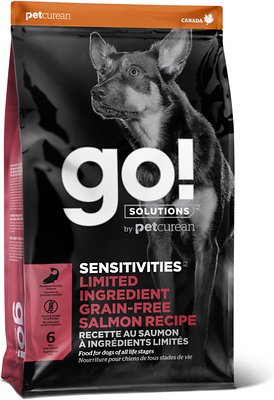
DogFoodAdvisor is reader supported See how
All reviews are 100% impartial but if you buy using links on this page, we may earn a referral fee.
Which Go! Solutions Sensitivities Recipes Get Our Best Ratings?
Go! Solutions Sensitivities Limited Ingredient Dry Dog Food receives the Advisor’s second-highest tier rating of 4 stars.
Please note: One of the recipes in the list below is currently unrated. This is because our review methodology favors dog foods rich in meat and the criteria is not applicable for foods made from insect protein. Studies of insect-based diets for dogs are showing some great results but we’ll leave this recipe unrated for now whilst we consider how best to fairly rate this new area of the dog food market.
The Go! Solutions Sensitivities Limited Ingredient product line includes the 7 dry dog foods listed below.
Each recipe includes its AAFCO nutrient profile when available… Growth (puppy), Maintenance (adult), All Life Stages, Supplemental or Unspecified.
Recipe and Label Analysis
Go! Solutions Sensitivities Limited Ingredient Grain Free Salmon was selected to represent the other products in the line for detailed recipe and nutrient analysis.
Label and nutrient data below are calculated using dry matter basis.
Go! Solutions Sensitivities Limited Ingredient Grain Free Salmon
Estimated Dry Matter Nutrient Content
Protein
Fat
CarbsCarbohydrates
De-boned salmon, salmon meal, tapioca, peas, lentils, chickpeas, pea flour, canola oil (preserved with mixed tocopherols), coconut oil (preserved with mixed tocopherols), calcium carbonate, dicalcium phosphate, natural fish flavor, salt, dried chicory root, choline chloride, potassium chloride, vitamins (vitamin A supplement, vitamin D3 supplement, vitamin E supplement, niacin, l-ascorbyl-2-polyphosphate (a source of vitamin C), thiamine mononitrate, d-calcium pantothenate, riboflavin, pyridoxine hydrochloride, beta-carotene, folic acid, biotin, vitamin B12 supplement), minerals (zinc proteinate, iron proteinate, copper proteinate, zinc oxide, manganese proteinate, copper sulfate, ferrous sulfate, calcium iodate, manganous oxide, selenium yeast), taurine, dried rosemary
Fiber (estimated dry matter content) = 4.5%
Red denotes any controversial items
| Estimated Nutrient Content | |||
|---|---|---|---|
| Method | Protein | Fat | Carbs |
| Guaranteed Analysis | 24% | 12% | NA |
| Dry Matter Basis | 27% | 13% | 52% |
| Calorie Weighted Basis | 24% | 29% | 47% |
Ingredient Analysis
The first ingredient in this dog food is salmon. Although it is rich in omega-3 fatty acids, raw salmon contains up to 73% water. After cooking, most of that moisture is lost, reducing the meat content to just a fraction of its original weight.
After processing, this item would probably account for a smaller part of the total content of the finished product.
The second ingredient is salmon meal. Because it is considered a meat concentrate, fish meal contains almost 300% more protein than fresh fish itself.
Fish meal is typically obtained from the “clean, dried, ground tissue of undecomposed whole fish and fish cuttings” of commercial fish operations.1
The third ingredient is tapioca, a gluten-free, starchy carbohydrate extract made from the root of the cassava plant.
The next ingredient includes peas, which are a quality source of carbohydrates. And like all legumes, they’re rich in natural fiber.
The fifth ingredient lists lentils. Lentils are also a quality source of carbohydrates. Plus (like all legumes) they’re rich in natural fiber.
However, both peas and lentils each contain about 25% protein, a factor that must be considered when judging the actual meat content of this dog food.
The sixth ingredient includes chickpeas, also known as garbanzo beans. Like peas, beans and lentils, the chickpea is a nutritious member of the fiber-rich legume (or pulse) family of vegetables and contains about 22% protein.
The seventh ingredient is pea flour, a powder made from roasted yellow peas. Pea flour contains as much as 25% protein, a factor that must be considered when judging the meat content of this dog food.
It’s important to note that a number of ingredients included in this recipe are each a type of legume:
- Peas
- Lentils
- Chickpeas
Although they’re a mixture of quality plant ingredients, there’s an important issue to consider here. And that’s the recipe design practice known as ingredient splitting.
If we were to combine all these individual items together and report them as one, that newer combination would likely occupy a significantly higher position on the list.
The eighth ingredient is canola oil. Unfortunately, canola can be a controversial item. That’s because it can sometimes (but not always) be derived from genetically modified rapeseed.
Yet others cite the fact that canola oil can be a significant source of essential omega-3 fatty acids.
In any case, plant-based oils like canola are less biologically available to a dog than fish oil as a source of quality omega-3 fats.
The ninth ingredient is coconut oil, a natural oil rich in medium-chain fatty acids.
Medium-chain triglycerides have been shown to improve cognitive function in older dogs.2
Because of its proven safety3 as well as its potential to help in the treatment of canine cognitive dysfunction syndrome (CDS) and chronic skin disorders, MCT can be considered a positive addition to this recipe.
From here, the list goes on to include a number of other items.
But to be realistic, ingredients located this far down the list (other than nutritional supplements) are not likely to affect the overall rating of this Petcurean product line.
With 4 notable exceptions…
First, chicory root is rich in inulin, a starch-like compound made up of repeating units of carbohydrates and found in certain roots and tubers.
Not only is inulin a natural source of soluble dietary fiber, it’s also a prebiotic used to promote the growth of healthy bacteria in a dog’s digestive tract.
Next, this food contains chelated minerals, minerals that have been chemically attached to protein. This makes them easier to absorb. Chelated minerals are usually found in better dog foods.
In addition, we note the use of taurine, an important amino acid associated with the healthy function of heart muscle. Although taurine is not typically considered essential in canines, some dogs have been shown to be deficient in this critical nutrient.
Since taurine deficiency appears to be more common in pets consuming grain-free diets, we view its presence in this recipe as a positive addition.
And lastly, this recipe includes selenium yeast. Unlike the more common inorganic form of selenium (sodium selenite), this natural yeast supplement is considered a safer anti-cancer alternative.
Nutrient Analysis
Based on its ingredients alone, Petcurean’s Go! Solutions Sensitivities Limited Ingredient Dog Food looks like an above-average dry product.
The dashboard displays a dry matter protein reading of 27%, a fat level of 13% and estimated carbohydrates of about 52%.
As a group, the brand features an average protein content of 26% and a mean fat level of 13%. Together, these figures suggest a carbohydrate content of 52% for the overall product line.
And a fat-to-protein ratio of about 51%.
Which means this Petcurean product line contains…
Above-average protein. Below-average fat. And above-average carbs when compared to a typical dry dog food.
But when you consider the protein-boosting effect of the pea products, lentils and chickpeas, this looks like the profile of a kibble containing just a moderate amount of meat.
Our Rating of Go! Solutions Sensitivities Limited Ingredient Dog Food
Go! Solutions Sensitivities Limited Ingredient is a grain-free dry dog food that uses a moderate amount of named meat meals as its dominant source of animal protein, thus earning the brand 4 stars.
Highly recommended.
However, it’s unfortunate the company chose to include so much plant-based protein in its recipe. Otherwise, we would have been compelled to award this product a higher rating.
Petcurean Dog Food Recall History
The following automated list (if present) includes all dog food recalls related to Petcurean through July.
No recalls noted.
You can view a complete list of all dog food recalls since 2009 here.
Get Free Recall Alerts
Get free dog food recall alerts sent to you by email. Subscribe to The Advisor’s recall notification list.
More Top Picks
More Petcurean Brand Reviews
The following Petcurean dog food reviews are also posted on this website:
- Gather Dog Food Review (Dry)
- Go! Solutions Carnivore Dog Food Review (Dry)
- Go! Solutions Sensitivities Dog Food Review (Wet)
- Go! Solutions Skin + Coat Care Dog Food Review (Dry)
- Now Fresh Dog Food Review (Dry)
- Now Fresh Wet Dog Food Review (Cartons)
- Summit Dog Food Review (Dry)
Compare This Dog Food
How does this brand compare with The Dog Food Advisor's most recommended brands?
Sources
A Final Word
The Dog Food Advisor does not accept money, gifts, samples or other incentives in exchange for special consideration in preparing our reviews.
However, we do receive a referral fee from online retailers (like Chewy or Amazon) and from sellers of perishable pet food when readers click over to their websites from ours. This helps cover the cost of operation of our free blog. Thanks for your support.
For more information, please visit our Disclaimer and Disclosure page.








